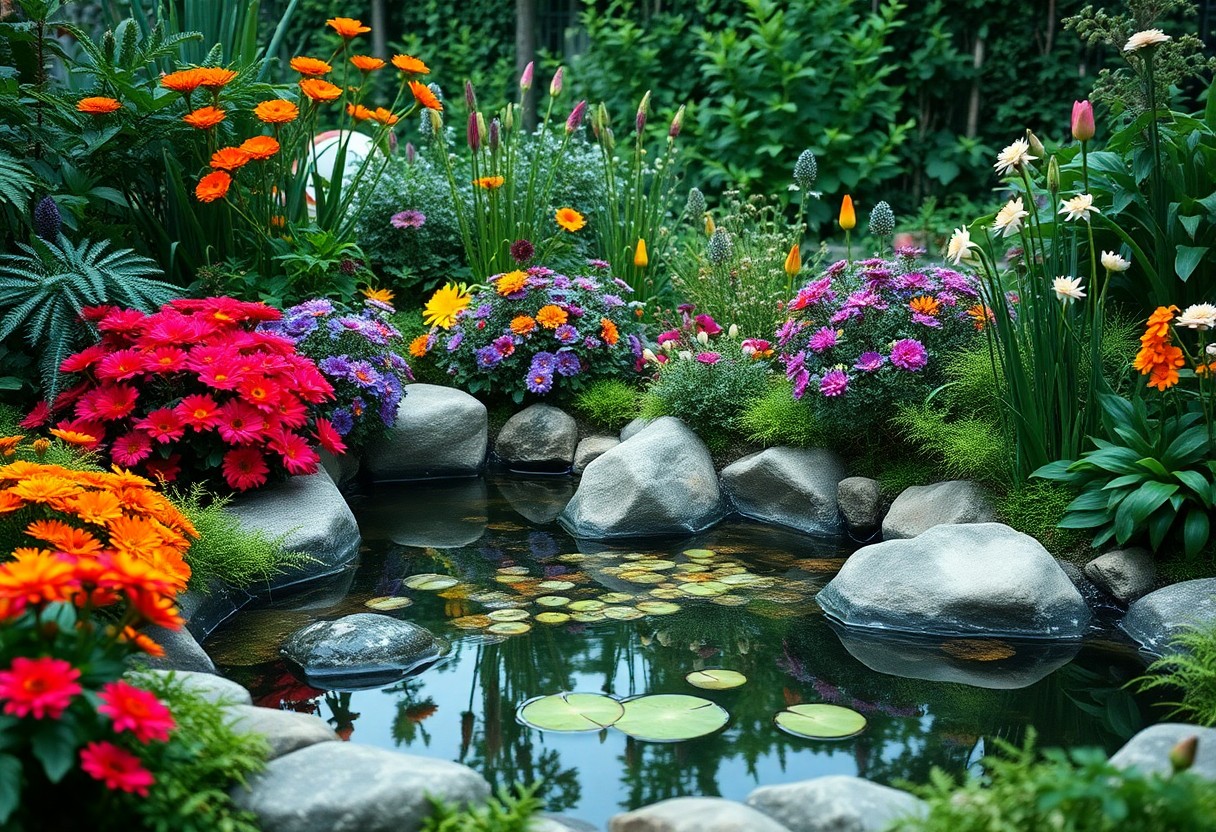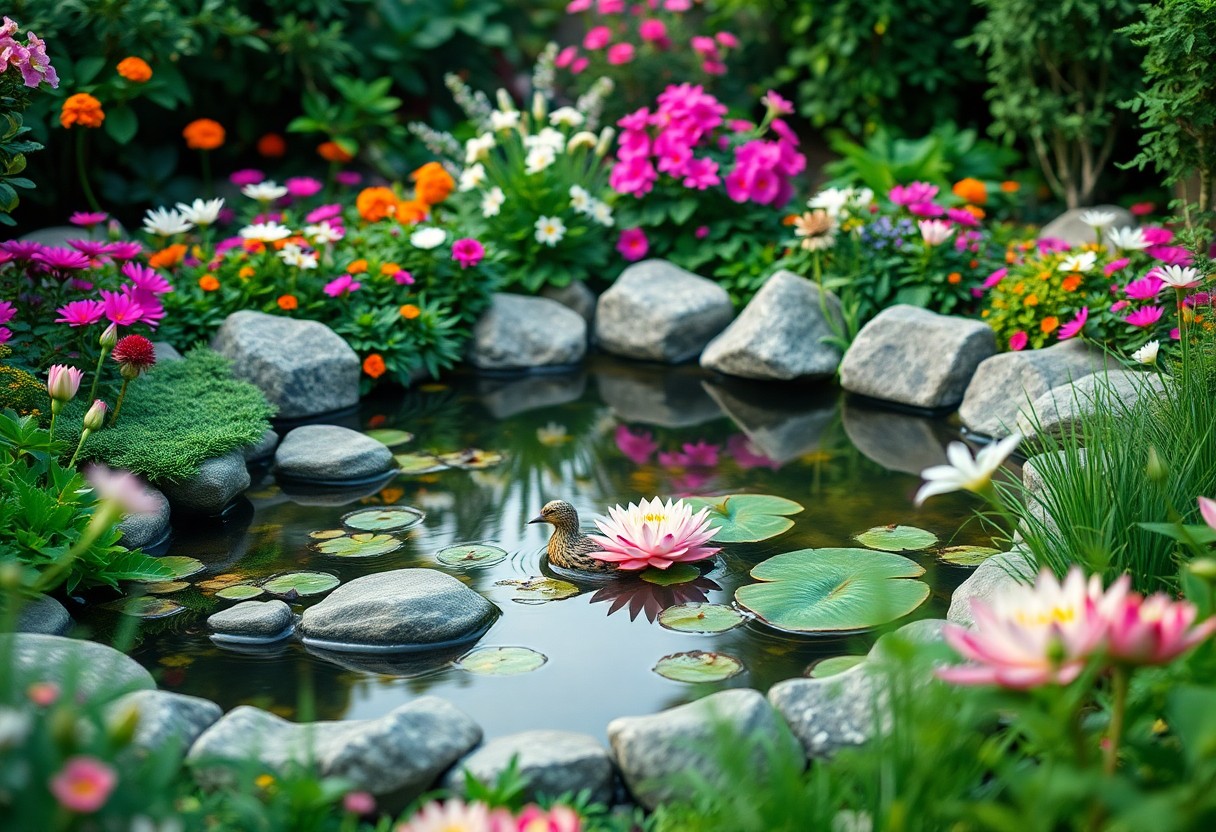Pond aesthetics can be significantly enhanced by thoughtfully selecting and placing plants around its edges. As you create this aquatic oasis, consider the light conditions, water levels, and plant types that will harmonize with your pond’s ecosystem. Choose native and aquatic species that thrive in your region while ensuring they won’t disrupt local wildlife. By following a few simple tips, you’ll transform your pond area into a serene and inviting landscape, perfect for relaxation and enjoyment.
Table of Contents
Key Takeaways:
- Select plants that thrive in moist conditions and can tolerate occasional flooding.
- Incorporate a mix of heights and textures to create visual interest around the pond.
- Avoid invasive species that could disrupt the ecosystem of the pond.
- Maintain a balanced ratio of aquatic and terrestrial plants to support wildlife.
- Consider the sun and shade levels in different areas around the pond to choose appropriate plants.

Planning Your Pond Garden
A well-planned pond garden enhances the beauty of your outdoor space while creating a habitat for wildlife. Begin by considering the overall design, including plant types and their placement relative to the pond. Think about your garden’s aesthetics, maintenance needs, and how various plants will thrive alongside your water feature.
Assessing Light and Shade Conditions
Conditions around your pond play a significant role in plant selection. Observe how much sunlight your garden receives at different times of the day and note areas that are predominantly shaded. This will help you choose plants that will thrive in your specific light conditions, ensuring a flourishing garden.
Understanding Soil Requirements
On your pond garden journey, you must evaluate the soil quality in the area surrounding the water feature. Different plants have varying nutrient and drainage needs, so understanding your soil type will guide your plant choices. You may need to improve your soil by adding organic matter or adjusting pH levels to create a healthy growing environment.
Assessing your soil is imperative for success in your pond garden. Start by determining if your soil is clay, sandy, or loamy. Clay retains water while sandy soil drains quickly, impacting plant growth. Perform a simple test by checking drainage; plants near water should not sit in standing water. Improving your soil—with compost or peat moss—helps retain moisture and provides necessary nutrients for plants, establishing a vibrant ecosystem around your pond.
Essential Planting Factors
It’s vital to consider several crucial planting factors when adding greenery around your garden pond. These include:
- water availability
- sunlight exposure
- soil type
- plant height
- plant spacing
Perceiving these aspects will help you create a harmonious environment. If you’re seeking ideas, check out What can or should I plant around my pond? : r/landscaping.
Water Depth Considerations
Any garden pond has different areas of water depth, which affects the types of plants that thrive. Shallow zones tend to support marginal plants, while deeper areas favor submerged or floating varieties. Assess your pond depth to select the most suitable flora.
Plant Hardiness Zones
Water your choices in plant types by understanding plant hardiness zones. Each zone represents a unique climate that affects what plants can survive the winter. Plants designated for your zone will thrive best, preventing unexpected die-offs during cold months.
Zones are determined based on minimum winter temperatures and play a significant role in plant survival. Choosing plants suited to your specific zone ensures they can handle local weather conditions and thrive. Ignoring this factor may expose you to the risk of losing your investments as unsuitable plants struggle or perish. Always check your local hardiness zone to plant successfully.
Plant Selection Guidelines
Once again, selecting the right plants is necessary for creating a balanced and visually appealing garden pond. Consider native species that thrive in your local climate, as they require less maintenance and support local wildlife. For comprehensive options, check out this Best Pond Edge Plants – 2023 Pond Vegetation Guide to help you make informed choices.
Marginal Plants and Bog Plants
For adding dimension and habitat to your pond, consider incorporating marginal and bog plants. These plants thrive in shallow waters along the pond’s edge and help filter the water, while also providing shelter for fish and other wildlife.
Deep Water and Floating Plants
Water quality and aesthetic appeal are greatly influenced by deep-water and floating plants. They provide shade, reduce algae growth, and offer refuge for aquatic life.
The deep-water plants need to be submerged and can be necessary for maintaining a balanced ecosystem. Moreover, floating plants create an important canopy that helps reduce sunlight penetration, which minimizes algae growth. They also serve as a natural habitat and food source for various aquatic organisms. When opting for these plants, ensure they are non-invasive to prevent overcrowding in your pond system.
Strategic Planting Tips
Many gardeners overlook the importance of strategic planting around a garden pond. To create a harmonious ecosystem and enhance your pond’s beauty, consider these tips:
- Choose plants that thrive in moisture-rich soil.
- Incorporate a mix of native species and ornamental plants.
- Group plants with similar light and water needs.
- Avoid invasive species that can dominate your pond’s ecosystem.
Assume that following these guidelines will lead to a well-balanced and attractive garden space.
Proper Spacing and Arrangement
For optimal growth and aesthetics, ensure you maintain proper spacing and arrangement of your plants. This allows airflow and sunlight to reach each plant effectively, promoting healthy growth. Additionally, consider the mature size of your plants to avoid overcrowding, which can lead to competition for nutrients and water.
Seasonal Planting Times
On the topic of timing, planting your garden around the pond should align with the seasons. Each plant species has its preferred planting time, which can significantly affect their growth and health. By planting during the optimal season, you will enhance the appearance and longevity of your garden.
For instance, spring is typically the best time for planting many perennials, as they can establish their roots before the heat of summer. Conversely, fall is ideal for certain species that benefit from cooler temperatures, allowing for robust growth come spring. Be cautious with your timing; planting too late in the season can expose young plants to harsh conditions, while early planting may lead to frost damage. By synchronizing your planting times with seasonal changes, you ensure a vibrant and thriving garden around your pond.
Maintenance Considerations
Now that your garden pond is beautifully surrounded by lush plants, it’s important to consider ongoing maintenance. Regular upkeep ensures that your plants stay healthy and do not overwhelm the pond. Check for signs of overgrowth, disease, and pests, and adapt your care routine to keep the ecosystem balanced. Incorporating an easy-to-follow schedule for watering, pruning, and fertilizing will help maintain the vibrant aesthetics of your garden while safeguarding the pond’s habitat.
Pruning and Dividing Plants
Plants surrounding your garden pond will thrive best with periodic pruning and dividing. This practice helps control their size and spread, ensuring they do not overshadow the water feature or compete for resources. Prune back overgrown stems and dead foliage to promote healthy growth and a tidy appearance. Dividing larger plants in the spring or fall can also rejuvenate them, producing more vigorous growth and preventing overcrowding.
Managing Plant Growth
To keep your pond’s flora in check, managing plant growth is vital to your gardening success. Regular monitoring allows you to assess what areas may require intervention. Utilizing techniques such as selective pruning, strategic thinning, and even relocating plants can promote a harmonious balance around your pond. If you discover any invasive species, it’s important to remove them promptly to maintain the integrity of your ecosystem.
Another key aspect of managing plant growth is understanding the specific needs of each plant species. Some may require more water or sunlight compared to others, leading them to outgrow their space quickly. Keep an eye out for any signs of stunted growth or nutrient deficiency, as these may indicate an imbalance in your garden’s ecosystem. Additionally, maintaining good airflow around your plants can prevent fungal diseases, ensuring your garden remains vibrant and healthy.
Common Planting Challenges
Keep in mind that planting around a garden pond can come with various challenges, such as maintaining soil moisture levels, selecting the right plants, and managing the balance between aesthetic appeal and plant health. Understanding these common issues will help you create a beautiful and thriving pondside garden.
Controlling Invasive Species
Assuming you opt for native plants around your pond, be aware that invasive species can still infiltrate the area. These aggressive plants can easily outcompete your chosen flora and overwhelm your garden. Regular monitoring and removal of invasive species will ensure the health of your pond’s ecosystem and preserve the beauty of your landscape.
Dealing with Water Quality Issues
Invasive species can affect your pond’s water quality by introducing excess nutrients and ultimately leading to algae blooms. It’s important to maintain your pond’s balance by regularly testing the water for pH, ammonia, and nitrate levels. Implementing natural filtration systems like aquatic plants or making adjustments to your planting design can boost oxygenation and improve water clarity. Be vigilant in monitoring conditions to ensure your garden thrives harmoniously with the pond environment.
To wrap up
To wrap up, creating a stunning landscape around your garden pond involves careful selection of plants that thrive in the unique conditions of this aquatic environment. You should consider native plants, water lilies, and other pond-friendly species that not only enhance beauty but also support local wildlife. Arrange your plants in layers, placing taller varieties at the back and shorter ones in front for a visually appealing design. Lastly, ensure proper maintenance, such as trimming and watering, to keep your pond area vibrant and healthy. With these steps, your garden pond will become a picturesque focal point in your outdoor space.
FAQ
Q: What types of plants are best for planting around a garden pond?
A: When choosing plants for around a garden pond, consider varieties that thrive in a moist environment. Aquatic plants like water lilies, canna lilies, and irises are great for the water’s edge. You can also incorporate perennial plants such as ferns, hostas, and ornamental grasses, which can add texture and color to the landscape surrounding the pond.
Q: How far away from the pond should I plant shrubs or larger plants?
A: It is generally advisable to plant larger shrubs or trees at least 3 to 5 feet away from the pond’s edge. This distance helps to maintain a healthy balance in the pond ecosystem, allowing for adequate drainage and preventing excessive leaf litter and debris from falling into the water.
Q: Can I use decorative stones or gravel around my garden pond?
A: Yes, decorative stones and gravel can be used effectively around a garden pond. They not only enhance the aesthetics but also help with drainage and prevent soil erosion. Ensure the materials you choose do not contain harmful chemicals that may leach into the pond water.
Q: How should I plan the layout of my plants around the pond?
A: To plan the layout, consider creating layers of height with taller plants at the back and shorter ones in front. This will create visual interest and ensure that each plant is visible. Additionally, group plants in odd numbers or clusters for a more natural look, and leave space for maintenance access around the pond.
Q: What maintenance should I expect for the plants around my garden pond?
A: Expect regular maintenance such as watering, particularly during dry spells, as well as pruning and deadheading to encourage growth. It is also important to check for invasive species or pests that may harm your plants or the pond ecosystem. Seasonal clean-up is beneficial to remove debris and fallen leaves that may fall into the pond.

